- Home
- Free Quilt Block Patterns
- Amish Star Quilt Block
Amish Star Quilt Block: Where Tradition Meets Celestial Beauty
Sew Many Stars, Sew Little Time! ⏰💫
This post contains affiliate links, for which I receive compensation.
With all its patches, an Amish Star quilt block looks more complicated than it really is—it's just a simple 9-patch.
We'll use the 8-at-a-time method to make our Half Square Triangles. Paper piecing the Flying Geese makes for perfect units every time.
What? Not a fan of paper piecing?

Don't worry. A connector corners method is provided just for you.
Everything else is just cut squares and rectangles.
You CAN do it!
Let's get STAR-ted!
🧭Quick Navigation🔍
Use these handy anchor links to navigate through our tutorial galaxy.
- A cutting chart in four sizes with a download of the chart and block design
- A download of the paper piecing patterns and templates for each size
- A coloring/fabric planning page to download and print
Cut. Sew. Press. Turn your fabric into a constellation of creativity!
📋 General Instructions
These abbreviations are used on this page:
- SA - seam allowance
- RST - right sides together
- HST - half square triangle
- FG - Flying Geese
Label your patches as you cut them.
SA are 1/4" and pressed towards the darker fabric unless noted otherwise.
To make pressing instructions easier to find, they are highlighted in yellow.
I like to starch my quilt fabric with a 50/50 mixture of liquid starch concentrate and water before cutting.
In my humble opinion, cutting and stitching is more accurate with nicely pressed, starched fabric.
I also like being able to fingerpress my seams as I go.
✂️ Cut patches for an Amish Star
 Amish Star design
Amish Star designSample Size: 6" finished / 6½" unfinished
Grid: 6x6
Attributed to: Jean DuBois
Design Type: Star | Even 9-patch, Star
Two fabrics are all you'll need to make this beauty!
The green cutting chart is for traditional piecing with folded corners.
If you prefer to use paperpiecing to piece your Flying Geese units, use the blue charting.
Instructions are provided for both methods.
The best way is the one that works best for you!
Traditional piecing with Folded Corners
To print a copy of the block design and cutting chart to use at your cutting table, click here.
 | Cutting Chart for an~ Traditional Piecing w/Folded Corners ~ | |||||
|---|---|---|---|---|---|---|
| Patch | Fabric | Qty | Finished Block Size | |||
| 6'' | 9'' | 12'' | 18'' | |||
| 1 | Light | 1 | 4¼'' x 4¼'' | 5¼'' x 5¼'' | 6¼'' x 6¼'' | 8¼'' x 8¼'' |
| 2 | Dark | 1 | 4¼'' x 4¼'' | 5¼'' x 5¼'' | 6¼'' x 6¼'' | 8¼'' x 8¼'' |
| 3 | Dark | 1 | 1½'' x 1½'' | 2'' x 2'' | 2½'' x 2½'' | 3½'' x 3½'' |
| 4 | Light | 4 | 1½'' x 2½'' | 2'' x 3½'' | 2½'' x 4½'' | 3½'' x 6½'' |
| 5 | Light | 4 | 2½'' x 2½'' | 3½'' x 3½'' | 4½'' x 4½'' | 6½'' x 6½'' |
| Goose | Dark | 8 | 1½'' x 2½'' | 2'' x 3½'' | 2½'' x 4½'' | 3½'' x 6½'' |
| Sky | Light | 4 | 1½'' x 1½'' | 2'' x 2'' | 2½'' x 2½'' | 3½'' x 3½'' |
| Unfinished Block Size | 6½'' | 9½'' | 12½'' | 18½'' | ||
| Grid Size | 1'' | 1½'' | 2'' | 3'' | ||
Includes some paper piecing
My personal preference is to paper piece my Flying Geese. If it's yours, too, use this blue cutting chart to cut your patches.
To print a copy of the block design and cutting chart to use at your cutting table, click here.
 | Cutting Chart for an~ Includes Paper Piecing ~ | ||||||
|---|---|---|---|---|---|---|---|
| Patch | Fabric | Qty | Finished Block Size | Sub Cut | |||
| 6'' | 9'' | 12'' | 18'' | ||||
| 1 | Light | 1 | 4¼'' x 4¼'' | 5¼'' x 5¼'' | 6¼'' x 6¼'' | 8¼'' x 8¼'' | --- |
| 2 | Dark | 1 | 4¼'' x 4¼'' | 5¼'' x 5¼'' | 6¼'' x 6¼'' | 8¼'' x 8¼'' | --- |
| 3 | Dark | 8 | 1½'' x 1½'' | 2'' x 2'' | 2½'' x 2½'' | 3½'' x 3½'' | --- |
| 4 | Light | 4 | 1½'' x 2½'' | 2'' x 3½'' | 2½'' x 4½'' | 3½'' x 6½'' | --- |
| 5 | Light | 1 | 2½'' x 2½'' | 3½'' x 3½'' | 4½'' x 4½'' | 6½'' x 6½'' | --- |
| Goose | Dark | 1 | 3⅝'' x 3⅝'' | 4⅝'' x 4⅝'' | 5⅝'' x 5⅝'' | 7⅝'' x 7⅝'' | |
| Sky | Light | 4 | 2⅜'' x 2⅜'' | 2⅞'' x 2⅞'' | 3⅜'' x 3⅜'' | 4⅜'' x 4⅜'' | |
| Unfinished Block Size | 6½'' | 9½'' | 12½'' | 18½'' | na | ||
| Grid Size | 1'' | 1½'' | 2'' | 3'' | na | ||
Optional Download: Paperpiecing patterns
If you cut your Amish Star patches from the blue cutting chart, you MUST print paperpiecing patterns.
You'll need the most current version of Adobe installed on your computer to download the pattern.
On the Adobe Print Menu page, under 'Page Size and Handling' set 'Custom Scale' to 100% before printing for accurate results. Click here to see what it looks like on the Print Menu page.
After printing, use the 1" square graphic on the printed pages to confirm they are printed accurately.
To access the pattern choose your finished block size from the chart below and print the corresponding page:
Print Flying Geese Patterns | ||
|---|---|---|
| Finished Block Size | # of copies | Link to PDF Download |
| 6" | 1 | 1" x 2" |
| 9" | 1 | 1½" x 3" |
| 12" | 1 | 2" x 4" |
| 18" | 2 | 3" x 6" |
Cut out all four units. A rough cut is good enough. There are no points for cutting exactly on the outside line of each. :)
🧵Create the units for our Amish Star quilt block
The block is divided into 'corners' and 'sides'. You need 4 of each.
Corners
Make 4
 Make 4
Make 4We use 8-at-a-time method to make our eight HSTs. If you are making a whole quilt of this block, you might want to try using triangle paper for faster piecing results.
Install your favorite 1/4" foot on your sewing machine.
Mark your #1 square:
- Draw a line from the top-left corner to the bottom-right corner.
- Draw another line from the top-right corner to the bottom-left corner.
Use a light touch. The mark should only be as dark as you need to see it.
For this sample, I've used my favorite Bohin Mechanical Chalk pencil for marking.
A funny thing happened on the way to making this block...
As with so many of the sample blocks I sew, this block was constructed at a Sunday Sew-In with my bee.
And as has happened way too many times lately, my favorite 1/4" foot for this job wasn't in the accessory tray. <heavy sigh!>
Thank goodness there's always more than one way to get things done in quilting.
I simply drew my stitching lines a quarter inch from both sides of each center diagonal line, snapped on my open toe applique foot, and stitched the HSTs.
Voila!
With RST layer #1 and #2. Stitch 1/4" from both sides of both lines.
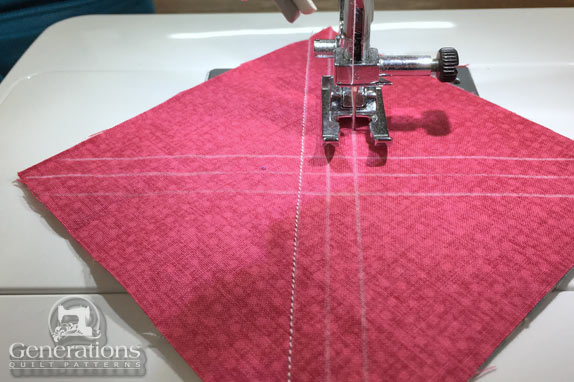 Open toe applique foot to the rescue!
Open toe applique foot to the rescue!Press flat to set the seams.
Now we cut the #1/#2 sewn unit into four equal squares. It's helpful to have either a smaller (12"x18") or rotating mat for this step.
Use the chart below to find the center measurement that corresponds to your chosen block.
HST Dimensions | ||
|---|---|---|
| Finished Block Size | Center or Midpoint Measurement | Trim HST to… |
| 6" | 2⅛" | 1½" |
| 9" | 2⅜" | 2" |
| 12" | 3⅛" | 2½" |
| 1" | 4⅛" | 3½" |
For my 6" sample, the center is 2-1/8".
Align that line on your ruler with the edge of the sewn squares (below).
Cut through the center of the block.

Turn the block a quarter turn and repeat the process. You'll have four equal squares.
Cut each in half on the diagonal line to create eight HST.
Press with the SA toward the darker #2.
Referring to the chart above, find your block size and trim each HST to size.
For more detailed instructions on this technique, click here.
To complete the Corners
With RST, add a #3 to the #1 side of each HST. Make a total of 8.

SAs are pressed toward #3 to avoid bulk.
Join 2 units together. The seams nest to make matching the seam line easier. Use pins as needed.
Press this seam as shown in the photo below.
 This seam is pressed towards the right as you look at the unit from the backside.
This seam is pressed towards the right as you look at the unit from the backside.Notice how the seams end up pressed toward the lower right red square (identified by the blue star).
Later, as you arrange the blocks into the Amish Star design, position that starred patch towards the center of the block. That way all your seams will nest.
Click here to see what the back of the finished block looks like and the location of that patch.
After stitching, this four-patch unit measures 2½"x2½", 3½"x3½", and 4½"x4½" edge-to-edge for the 6", 9" and 12" finished block sizes, respectively.
Sides
Make 4

If you cut your patches from the green chart, click here for a tutorial to make Flying Geese using the Folded or Connector Corner method.
Once finished, click the 'back' button on your browser bar to return here. Otherwise, continue on here for paperpiecing.
We need to make a few adjustments to our sewing machine settings to paper piece.
- Reduce your stitch length to 16–20 stitches per inch (1.3-1.6 mm). This perforates the paper and stabilizes the seam when you remove the pattern. [Learn more about stitch length here.]
- Reduce your machine's speed or just plain slow down. Sew only as fast as you can AND stay on the solid stitching line.
- Install an open toe appliqué foot (sometimes called an 'embroidery' or 'satin stitch' foot) if you have one (it makes it easier to see where you're stitching).
- Use a larger needle (90/14) IF you have problems removing the pattern. Personally, I use an 80/12 Microtex Sharp for paper piecing without any issues.
📢Updated Tutorial Note:
I've made the following improvements to the pattern since first writing this tutorial:
- Added labels for the Goose and Sky sections.
- Included both Finished and Unfinished Size measurements in the seam allowance area.
These updates make the pattern easier to use and more convenient for sorting and storing any leftover pieces for future projects.
I use a tiny dot of Elmer's Washable Glue Stick to hold the Goose patch in place. Dashed placement lines(blue arrow) make positioning quick.
 Used the dashed lines for placement
Used the dashed lines for placementAlign the long edge of a Sky with one short side of the Goose patch.
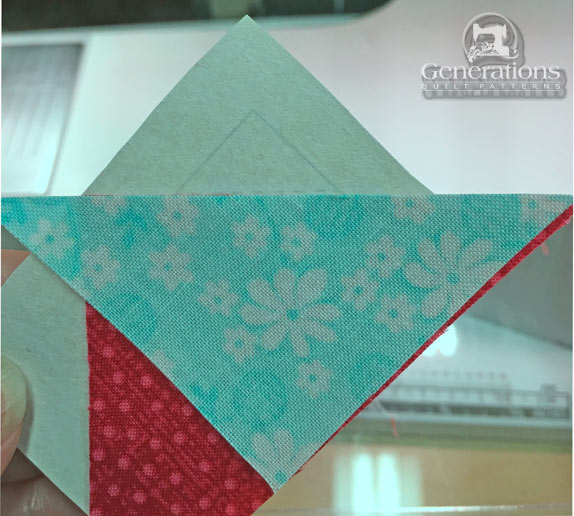
Stitch on the solid line between the two patches, starting and stopping past the outside light line that shows the outside edge of the unit.
Because this stitching line goes from outside edge to outside edge, you can chain piece your Flying Geese (below).

Press SAs toward the lighter Sky patch to avoid bulk.
Add the second Sky to the other short side in the same manner, pressing again towards the Sky.
Trim the FG to size. I prefer to lay the 1/4" line on my ruler on the solid outline of the block to trim accurately. It's much harder to line up the ruler exactly with the dashed line.
After trimming and removing the paper, you've got four perfect patches.

To complete the sides, add a #4 rectangle to the bottom side of the goose (below).

Stitch with RST.
Press the SA toward #4.
Repeat for a total of four.

The paper piecing is complete. From this point forward, return your stitch length to the one you regularly use for piecing and install your favorite 1/4" presser foot.
🧩 Putting it all together
Arrange the units into the Amish Star quilt block design shown below. Solid patches are in the corners and the center sides.

Sew the rows together, again, pinning as needed.
 Insert a pin through points that need to match (left). After stitching (right).
Insert a pin through points that need to match (left). After stitching (right).Press SA in the direction of the arrows.
For help with pinning for perfection, click here.

With RST, stitch the rows together. SA will nest, making matching so much easier.
Pin as needed.
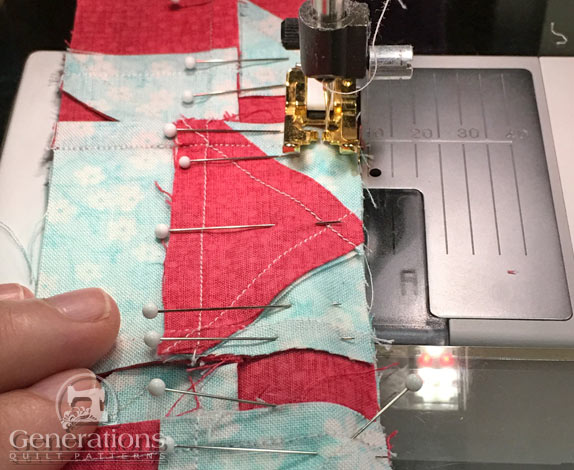
Here's our Amish Star from the backside (without the blue stars) to show how the SA were pressed.

...and from the front. Our Amish Star quilt block is ready to become part of a quilt top.
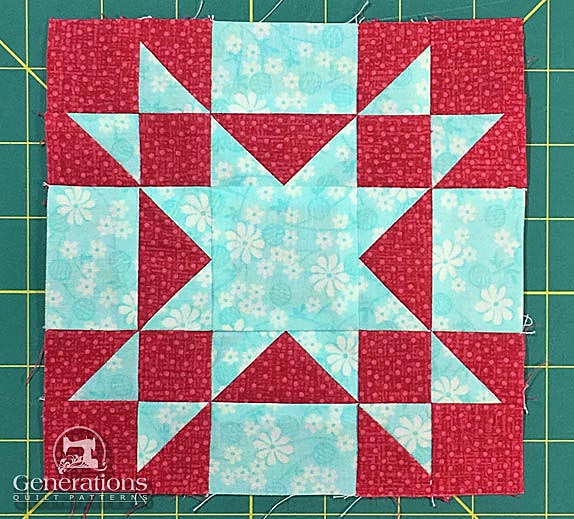
📌Don't let this stellar pattern get lost in a black hole🕳️
Pin it for your next galactic project! 📍

🔭 Looking for something truly stellar?
You've finished your star quilt block, and you're ready for more!
Browse our collection of 70 stellar star quilt block patterns. All have instructions and cutting charts in multiple sizes. If templates or paper piecing is used in the tutorial, there's a free download for you of those materials.
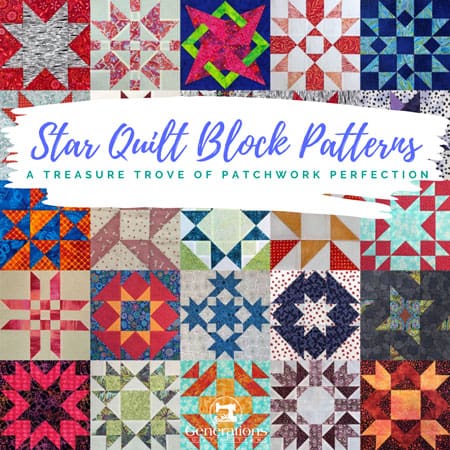
Eeny. Meenie. Miney. Moe.
Which star quilt block will you sew?
For a star-studded quilting experience, choose from 100+ bedazzling star quilt patterns—for beginners and beyond—click here.
For even MORE blocks to make… 🧩🎨

...visit our Free Quilt Block Pattern Library, with over 260+ blocks to choose from in multiple sizes.
Free downloads are included in all sizes for any blocks require paper piecing patterns or templates.
- Home
- Free Quilt Block Patterns
- Amish Star Quilt Block











